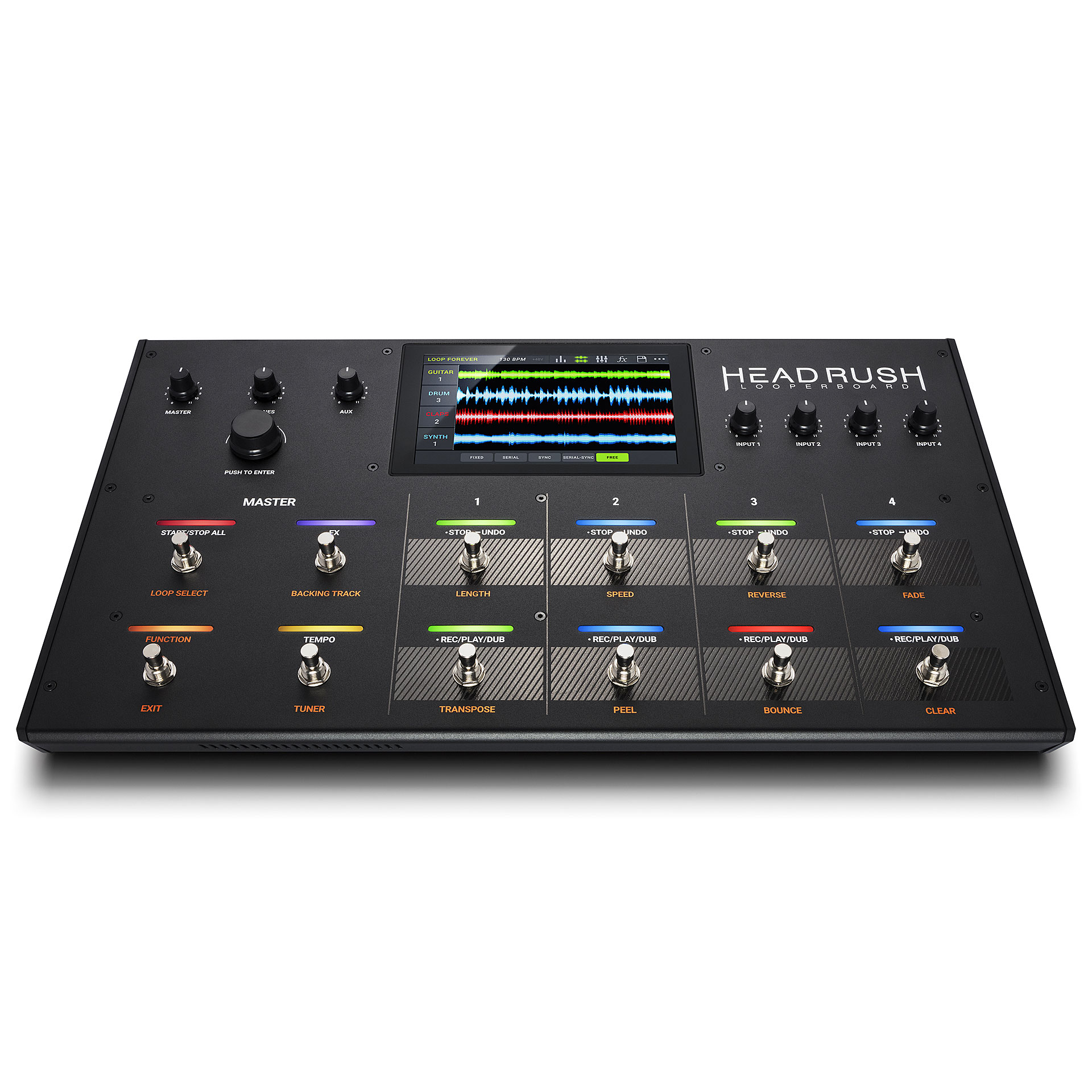
Introduction
Box Contents
Looperboard
USB Cable
Power Adapter
Software Download Card
Quickstart Guide
Safety & Warranty Manual
Support
For the latest information about this product (documentation, technical specifications, system requirements, compatibility information, etc.) and product registration, visit headrushfx.com.
For additional product support, visit headrushfx.com/support.
Features
Top Panel
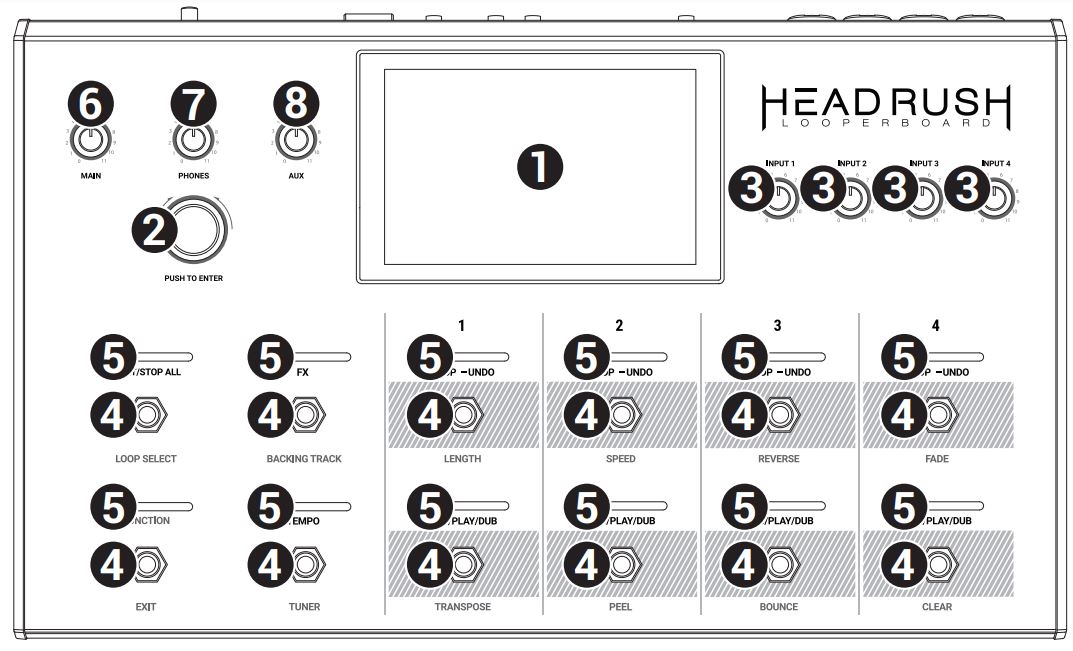
- Touchscreen: This full-color multi-touch display shows information relevant to the HeadRush Looperboard’s current operation. Touch the display (and use the hardware controls) to control the interface. See Operation > Overview to learn how it works.
- Encoder: Turn this encoder to scroll through the available menu options or adjust the parameter values of the selected field in the display. Push the encoder to confirm your selection.
- Input Gain: Turn these knobs to adjust the independent gain level of each input.
- Footswitches: Use these footswitches to perform different functions. The eight right-most footswitches correspond to the four tracks of a loop. See the Operation chapter to learn how to use them.
- Footswitch Indicators: These lights indicate the status of different functions (performed by the footswitch below each one). See the Operation chapter to learn about them.
- Main: Turn this knob to adjust the volume level of the outputs.
- Phones: Turn this knob to adjust the volume level of the Phones output.
- Aux: Turn this knob to adjust the volume level of the Aux input.
Important: The audio signal from the Aux input is routed directly y to the outputs and cannot be used for recording directly to a looper track. It is also unaffected by the main volume or irectly to a looper track. It is also unaffected by the main volume or phones volume knobs.
Rear Panel

- Power Input (19 VDC, 3.42 A, center-positive): Connect this input to a power outlet using the included power adapter.
- Power Adapter Restraint: Secure the power adapter cable to this restraint to prevent it from accidentally unplugging.
- Power Switch: Press this button to turn the HeadRush Looperboard’s power on. Press and hold this button to turn the HeadRush Looperboard’s power off.
- Vent: Make sure this vent is unobstructed while using the HeadRush Looperboard.
- Inputs (XLR or 1/4”/6.35 mm, balanced): Connect your guitar, instrument, drum machine, keyboard, or other audio source to these inputs. You can enable or disable +48V phantom power for these inputs in the Global Settings page.
Important: Only enable phantom power if your microphone requires it. Most dynamic microphones and ribbon microphones do not require phantom power, while most condenser microphones do. Consult your microphone’s documentation to find out whether it needs phantom power. - Aux Input (1/8”/3.5 mm, TRS): Connect an optional audio source (e.g., smartphone, tablet, etc.) to this input. Use the Aux knob to control the volume level.
- Outputs (XLR): Connect these outputs to the inputs of your mixer, active loudspeaker, etc. Use the Main knob to control the volume level. You can adjust the ground-lift setting for these outputs in the Global Settings page.
- Outputs (1/4”/6.35 mm, balanced): Connect these outputs to the inputs of your amplifier, audio interface, mixer, etc. Use the Main knob to control the volume level. You can switch the level of these outputs between Amp and Line in the Global Settings page.
- Phones Output (1/4”/6.35 mm, TRS): Connect stereo headphones to this output. Use the Phones knob to control the volume level.
- Expression Pedal Input (1/4”/6.35 mm, TRS): Connect an optional expression pedal to this input.
- MIDI In (5-pin DIN): Use a standard MIDI cable to connect this input to the MIDI output of an optional external MIDI device. See External MIDI Control for more information.
- MIDI Out/Thru (5-pin DIN): Use a standard MIDI cable to connect this output to the MIDI input of an optional external MIDI device. You can set this output to be a standard MIDI output or MIDI throughput in the Global Settings page.
- USB Type-B Port: Connect this USB port to a computer using a standard USB cable. This connection allows the HeadRush Looperboard to send and receive the digital audio signal to and from your computer. You can also use this connection to import or export loops, individual audio files, backing tracks, etc. See USB Connection for more information.This connection is also used to update the firmware. Visit headrushfx.com to check for available firmware updates.
- USB Type-A Ports: Connect USB flash drives to these USB ports for additional storage. You can save and load loops with the connected USB flash drive, as well as record loops directly to the flash drive itself. See Storage for more information.You can also play backing tracks directly from the USB drive. See Backing Track Player for more information.Lastly, you can connect class-compliant USB devices to these USB ports for external MIDI control. See External MIDI Control for more information.
- SD Card Slot: Insert a standard SD/SDHC card into this slot for additional storage. You can save and load loops with the inserted SD card, as well as record loops directly to the card itself. See Storage for more information.You can also play backing tracks directly from the SD card. See Backing Track Player for more information.Important: To avoid file loss or damage to your media, only disconnect USB and SD storage devices from HeadRush Looperboard while it is powered off. Alternatively, go to the Storage page and then tap the storage device’s eject icon.
Setup
Items not listed under Introduction > Box Contents are sold separately.

Operation
This chapter describes some of HeadRush Looperboard’s basic functions.
Overview
Timeline Page

Mixer Page

Navigation Menu
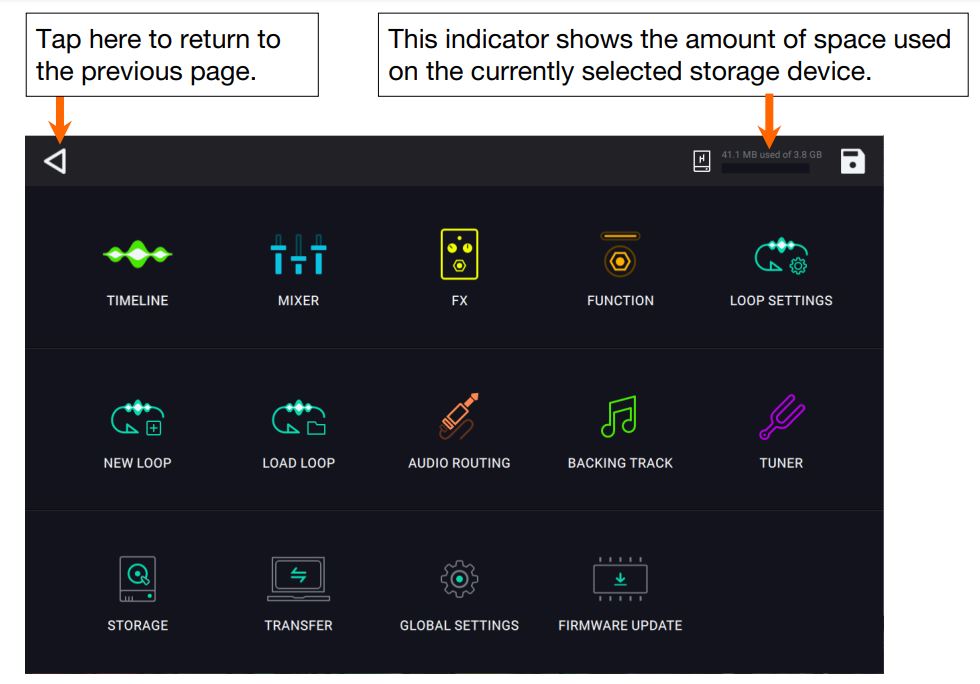
On the Navigation Menu page, you can tap an icon to quickly navigate to HeadRush Looperboard’s features:
- Timeline: Tap here to access HeadRush Looperboard’s timeline performance view.
- Mixer: Tap here to adjust volume and panning of looper tracks, the click track, and the backing track.
- FX: Tap here to assign and use the built-in FX.
- Function: Tap here to access the features of the Function footswitch.
- Loop Settings: Tap here to adjust the available settings that can be configured per loop.
- New Loop: Tap here to discard the current loop and create a new loop.
- Load Loop: Tap here to load a previously saved loop.
- Audio Routing: Tap here to adjust HeadRush Looperboard’s audio routing settings.
- Backing Track: Tap here to access the backing track player feature.
- Tuner: Tap here to access the tuner feature.
- Storage: Tap here to view available storage and to select a target storage device.
- Transfer: Tap here to enter USB Transfer Mode and transfer files to/from a computer.
- Global Settings: Tap here to adjust the available settings that can be adjusted globally.
- Firmware Update: Tap here to enter Firmware Update mode.
Recording & Playing Tracks
HeadRush Looperboard lets you record audio onto four tracks and store each set of four tracks as a loop. Each track can have up to 99 layers. Each track can be a minimum of 1 second long, with no maximum length limit. You can record, play, and stop tracks independently of each other depending on the loop mode and other settings.
Each track’s info box, meter, and/or waveform will use a color to indicate its current state:
- Red: recording or overdubbing
- Green: playing
- Blue: stopped

Use the Timeline page to view the waveforms of each track’s recorded audio in your loop.
To show the Timeline page, tap the Navigation Menu icon at the top left of the touchscreen, then tap the Timeline icon.
Use the Mixer page to adjust the volume levels and panning of each track.
To show the Mixer page, tap the Navigation Menu icon at the top left of the touchscreen, then tap the Mixer icon.
To adjust the volume level of a track, tap and drag the white line at the top of a meter.
To adjust the volume of the main outputs, turn the Main knob.
The left time counter in the bottom bar of the Timeline and Mixer pages indicates the current playback position of the loop. The right time counter in the bottom bar indicates the length of the longest track in the loop. Both are displayed as hours:minutes:seconds.centiseconds.
Tip: You can tap the Function footswitch twice to quickly return to the Timeline page from any other HeadRush Looperboard page.

To record a track, press its •Rec/Play/Dub footswitch.
Important: Before recording anything, set the input volume level by turning the Input (1–4) knob for each input you want to use.
To finish recording and start playback of a track, press its •Rec/Play/Dub footswitch again.
To overdub on a track that is currently playing, press the •Rec/Play/Dub footswitch again.
Tip: Use the Global Settings page to set HeadRush Looperboard to overdub immediately after recording a track (instead of just playing it).
To stop a track at any point, press its •Stop/–Undo footswitch.
To restart a track’s playback, press its •Stop/–Undo footswitch again.
To restart a track and immediately start overdubbing, press its •Rec/Play/Dub footswitch.
Tip: Use the Global Settings page to configure HeadRush Looperboard to restart a track’s playback without overdubbing when pressing the •Rec/Play/Dub footswitch.
To stop all tracks at any point, press the Start/Stop All footswitch when one or more tracks are playing.
To start playback of all tracks simultaneously, press the Start/Stop All footswitch when all tracks are stopped.
To undo everything you have recorded since you last pressed a •Rec/Play/Dub footswitch, press and hold the •Stop/–Undo footswitch for that track for approximately 1.5 seconds.
To re-add everything you just undid, press and hold the •Stop/–Undo footswitch for that track for approximately 1.5 seconds again.
To peel the most recent layer of a track, hold the •Rec/Play/Dub footswitch for approximately 1.5 seconds.
Important: If a track only has 1 layer, performing the undo function will clear the track, and the layer cannot be restored.
Tip: Use the Global Settings page to customize the hold functions for the •Stop/ Undo and •Rec/Play/Dub footswitches.
Looper Modes
HeadRush Looperboard provides 5 different Looper Modes to record, overdub and play your looper tracks. The currently selected Looper Mode is indicated in the bottom right of the touchscreen in the Timeline and Mixer Pages.
Generally, each mode supports a different style of looping workflow. The best way to find out which Track Mode works best with your workflow is to experiment and have fun!
To set how the looper records, overdubs, or plays your tracks, tap the Looper Mode tab on the Loop Settings page and then select a mode. You can access this setting quickly by tapping the Looper Mode icon in the Timeline or Mixer Pages.

Tip: Set your Looper Mode before recording or importing any audio into your loop. While you may be able to change the selected mode after recording, your options may be limited.
- Fixed Mode: Use this mode if you want 4 looper tracks with the same length. In this mode:
• You can record, overdub or play all looper tracks simultaneously.
• All track lengths will be the same length as the first recorded looper track.
• When you set a track to record, overdub or play, it will happen immediately. - Serial Mode: Use this mode if you want to use each of the 4 looper tracks as a different section of a song (e.g., verse, chorus, bridge and outro). In this mode:
• You can record, overdub or play on only one looper track at a time.
• All looper tracks can be different lengths.
• When you set a currently playing track to overdub, it will happen immediately.
• When you set a currently stopped track to play or record/overdub, it will happen as soon as the currently playing track reaches its end and stops. When a track is armed for playback or recording/overdubbing while another track is playing back, the corresponding LED will flash green or red, respectively. - Sync Mode: Use this mode if you want 4 looper tracks with different lengths that always stay in
sync. In this mode:
• You can record or play multiple tracks simultaneously.
• You must record a primary track first.
• After the primary track has been recorded, all other looper tracks must be the same length, or a multiple of its length.
• If new tracks are shorter or longer than the primary track, HeadRush Looperboard will automatically quantize them to keep them in sync with the primary track.
Tip: You can change how tracks start and stop in Sync Mode in the Track Start/Stop tab of the Loop Settings Page. - Serial-Sync Mode: This mode is similar to Serial Mode, but it enables you to keep 1 primary looper track (e.g., a drum or percussion track) playing at all times while switching between different song sections on looper tracks 2, 3 and 4 (e.g., verse, chorus and bridge). In this mode:
• The primary track and only one other looper track can be playing, recording or overdubbing at the same time.
• You must record a primary track first.
• After the primary track has been recorded, all other looper tracks must be the same length, or a multiple of its length.
• HeadRush Looperboard will auto-trim (or extend) the endpoints of the other looper tracks to always keep them in sync.
Tip: You can change how tracks start and stop in Serial-Sync Mode in the Track Start/Stop tab of the Loop Settings Page. - Free Mode: This mode is useful for creating ambient soundscapes or for musicians who just like to break the rules! In this mode:
• You can record, overdub or play all looper tracks simultaneously.
• All looper tracks can be different lengths.
• When you set a track to record, overdub or play, it will happen immediately.
Importing Audio
In addition to creating loops using input sources, you can also import a .WAV or .MP3 audio file (such as a recorded drum beat) directly into an empty looper track.
To import an audio file:
- While viewing the Timeline Page, tap the Import Audio icon on any empty track.
- Select a source by tapping one of the icons in the left column of the browser:
• Factory: This is a collection of over 300 exclusive drum and percussion loops provided by HeadRush.
• Internal: This is the internal storage of HeadRush Looperboard.
• USB 1/USB 2/SD: These sources will appear if you have external storage
connected to the respective ports on the rear panel of HeadRush Looperboard. - Use the touchscreen to navigate through folders, as necessary. You can search for an audio file in a folder by tapping in the search field in the top center of the touchscreen, next to the magnifying glass. Tap the X icon to clear your search.
- Select a file, and then tap the Play button if you would like to preview the audio file, or tap the Import button to load the audio file into the looper track.
- After tapping the Import button, a dialog will appear with up to 3 options:
• ADJUST BPM: This will change your loop’s tempo to match the automatically detected tempo of the imported audio file.
• MATCH BPM: This will change the imported audio file to match the current tempo of your loop.
• AS IS: This will import the audio file without changing the tempo of the audio file, or the tempo of your loop. - You may also need to indicate the number of bars of your imported file. You can tap the Play icon to preview the file for reference, if needed.
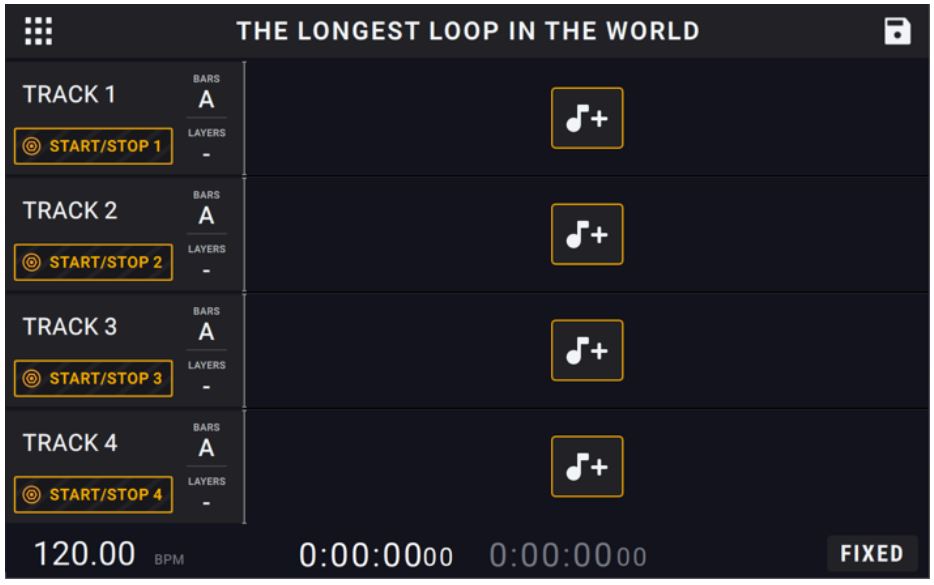
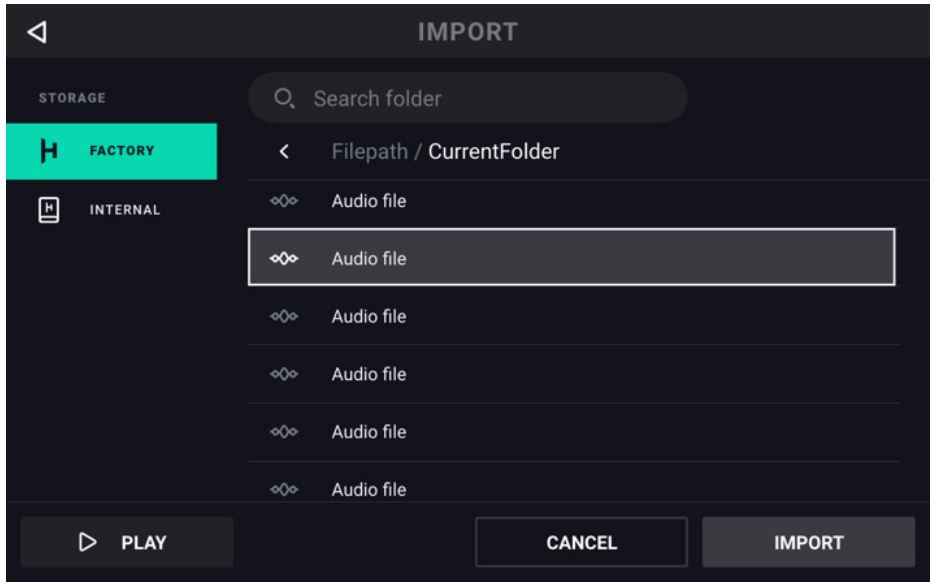

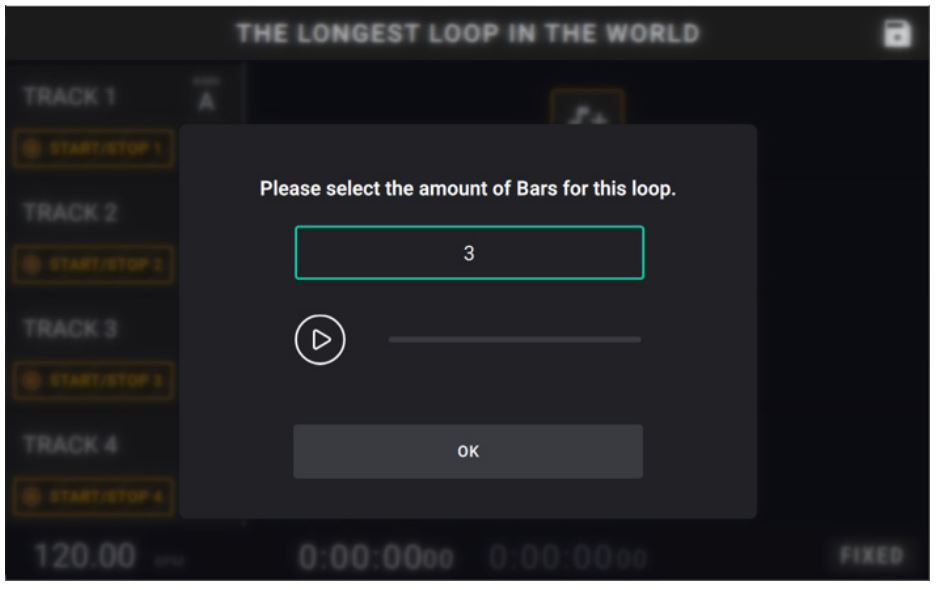
FX Racks
Applying FX
On the FX Page, you can assign multiple effects (called FX Racks) at once to an audio input or looper track. Each FX Rack is made up of multiple effects that can be individually edited and toggled on the FX Rack Edit page.

To enter the FX Page, press the footswitch labeled FX, or tap the Navigation Menu icon at the top-left of the touchscreen, and then tap the FX icon.
To add an FX Rack, tap the plus sign (+) in an empty slot.
To enable or bypass an FX Rack, tap the footswitches labeled 1–4, or tap the On/Off button on the touchscreen.
To change the FX Rack type of an existing FX Rack, tap the FX Rack icon on the touchscreen. This icon looks like a guitar, drums, etc.
To change the settings for the FX Rack, tap the knob icon on the touchscreen.
To remove an FX Rack, tap the X icon on the touchscreen.
To customize the footswitch assignments of the FX Racks, tap the Footswitch Assign button at the bottom of the touchscreen.
To assign FX parameters to an external expression pedal, tap the Expression Pedal Assign button at the bottom of the touchscreen.
To exit the FX Page, press the footswitch labeled FX, or tap the Navigation Menu icon in the topleft corner of the touchscreen.
Editing FX

To enable or bypass the full FX Rack, tap the Enable/Bypass button in the top-left corner of the touchscreen, underneath the back arrow.
To change the FX Rack type, tap the FX Rack drop-down menu, and then tap the FX Rack type you would like to load.
To load a factory or previously saved FX Rack preset, tap the Preset drop-down menu, and then tap the preset you would like to load.
To save your settings as an FX Rack preset, tap the save icon in the top right corner of the touchscreen.
To set the target audio for the FX Rack, tap the target dropdown menu and then select Inputs 1–4 or Tracks 1–4. If you have previously named your loop’s tracks, the new names will appear instead of Tracks 1-4.
To enable or bypass individual effects within the FX rack, tap the Enable/Bypass buttons located under each individual effect’s name.
To view and adjust an individual effect parameter within the FX rack, tap the individual FX rack’s name, and then tap and drag a parameter slider in the lower section. You can also tap the parameter slider and then turn the encoder for fine adjustment.
Footswitch Assignment
On the Footswitch Assign page, you can modify the functions of HeadRush Looperboard’s footswitches in an FX Rack.
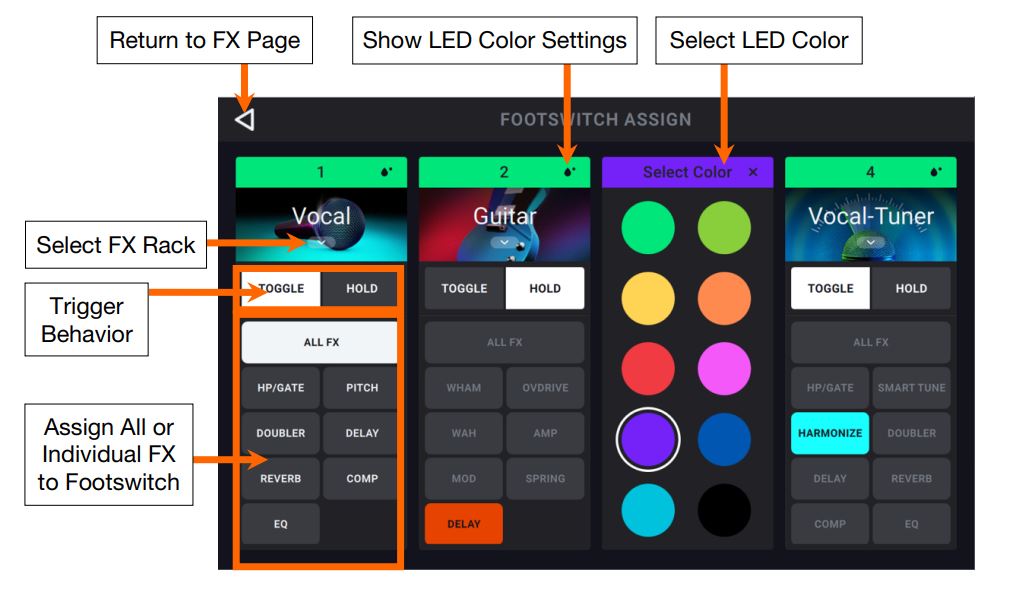
To select the FX Rack controlled by the footswitch, tap the icon that shows the name of the FX Rack (e.g., Vocal, Guitar, Lo-Fi), and then select the new FX Rack to control. To hide the selections, tap the block with the name of the FX Rack again.
To change the footswitch’s LED color, tap the Show LED Color icon on the top right corner of the FX rack to view the selectable colors. Tap to select the color, and then tap the X icon to hide the colors.
To change the trigger behavior of the footswitch, tap the block that says either Toggle or Hold (momentary). The text shown will be the behavior of that footswitch.
To assign a footswitch to enable/bypass all active FX within an FX Rack, tap to select the ALL FX block for the footswitch.
To assign a footswitch to enable/pass individual FX within an FX Rack, tap to select the desired individual FX blocks for the footswitch.
Expression Pedal Assignment
In the Expression menu, you can assign up to 4 parameters, volume or panning controls to your connected expression pedal.

To assign a parameter to the expression pedal, tap the + sign in an empty slot, and then select an FX Rack, looper track volume or looper track panning parameter to assign.
To change the range of the assigned parameter, tap the Range button. Tap the LO or HI % for the parameter, and then use the encoder to adjust the value.
Managing Loops
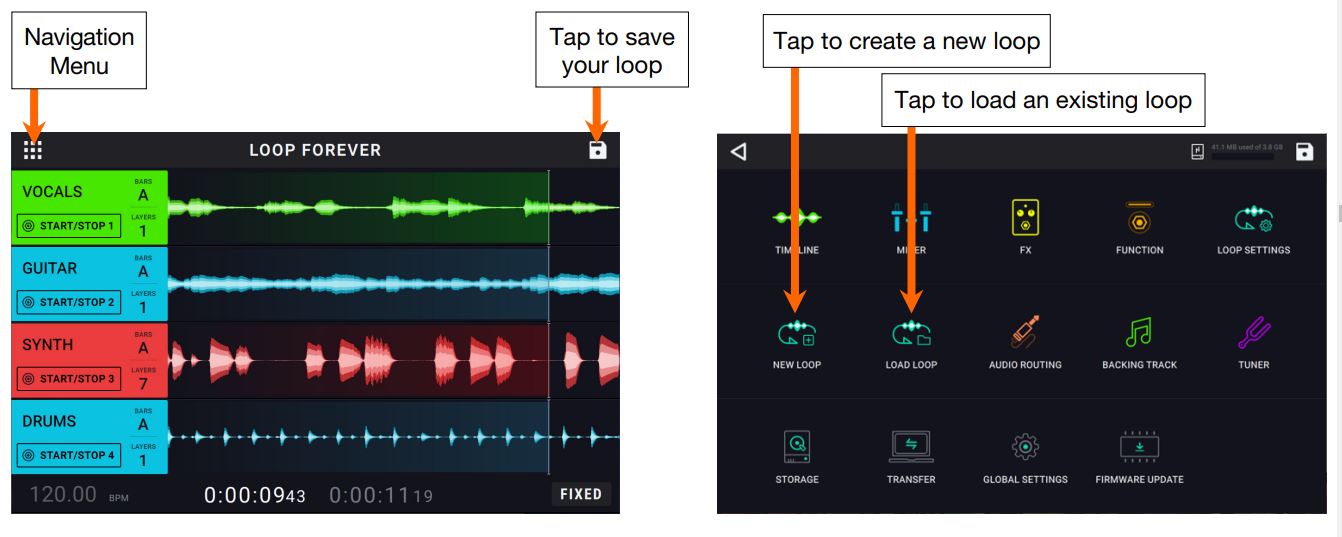

To create a new loop (and discard unsaved changes), tap the Navigation Menu icon, and then tap New Loop icon.
To save the current loop, tap the Save icon in the top right corner of the Timeline, Mixer, or Navigation Menu pages. Tap Save (to save over the existing file) or Save New Loop (to save the loop as a new file), or tap Cancel to return to the previous screen. A save browser will then appear for you to select your desired target storage device and folder for saving.
Note: When saving to a storage device using the exFAT or FAT32 file system, the maximum file size for saving .WAV files is 4GB (about 6 hours and 11 minutes of audio). If you are saving to a storage device using the FAT16 file system, then the limit for saving .WAV files is 2GB.
To load a previously saved loop, tap the Navigation Menu icon, and then tap the Load Loop icon. The Load Loop browser will then appear, where you can locate a loop and then tap the Load button to load it.
You can also Delete or Rename a previously saved loop in the load loop browser by tapping the loop name, and then tapping Delete or Rename buttons accordingly.
Tip: You can search for a Loop in a folder in the Load or Save Loop browsers by tapping in the search field in the top centre of the touchscreen, next to the magnifying glass. Tap the X icon to clear your search.
Loop Settings
Use the Loop Settings page to configure the settings for an individual loop.
To show the loop settings, tap the Navigation Menu icon in the top-left corner of the touchscreen, and then tap the Loop Settings icon.

Tempo and Click Tab:
Tempo: This setting determines the tempo of the loop. Tap the BPM on the touchscreen, and then use the encoder to set the current loop’s tempo, from 30–280 BPM.
Time Signature: This setting determines the time signature of the loop. Tap the time signature, and then use the encoder to set the time signature of the current loop: 2/4, 3/4, 4/4, 5/4, 6/4, 7/4, 5/8, 6/8, 7/8, 8/8, 9/8, 10/8, 11/8, 12/8, 13/8, 14/8 or 15/8.
Click: This setting determines the function of the click track. Set to Rec to enable while recording and overdubbing, or set to Play+Rec to enable when playing or recording and overdubbing. Set to Off to disable the click.
Count-In: This setting determines how the count-in feature functions. Set to On to enable the count-in before a loop starts to play, record or overdub. Tap the Bar value on the touchscreen and turn the encoder to adjust the number of measures for the count-in. Set to Off to disable the count-in.

Looper Mode Tab:
Looper Mode: Choose one of the five available Looper Mode settings on this tab for your loop. For more information about the Looper Mode settings, see the Looper Modes chapter of this manual.

Track Length and Quantize Tab:
Track Length: This setting enables you to predetermine the length of a looper track. Use the On/Off switch to enable/disable this feature. You can then tap the field to the right of the On/Off switch and use the encoder to set this parameter to AUTO or 1-64 bars.
When set to AUTO, HeadRush Looperboard determines the tempo of your loop based on the first recorded looper track. Any additional tracks also set to AUTO will match the same length as the first recorded track. The loop tempo can still be changed after it has been automatically detected by the first recording.
When set to 1-64 Bars, HeadRush Looperboard will set that individual track to be that specific length of bars, based on the loop’s current tempo.
If you are using the FIXED looper mode, there will be one TRACK LENGTH setting where you can set the length for all four looper tracks at once. If you are using the other looper modes (SERIAL, SYNC, SERIAL-SYNC, FREE) you can select TRACK LENGTH for all four tracks individually.
When using the SYNC and SERIAL-SYNC looper track modes, the TRACK LENGTH setting will only apply to the first recorded track. This is to stay consistent with the existing rules of these modes and ensure that all other looper tracks are either the same length, or a multiple of its length. In this case, AUTO will be selected for all tracks recorded after the first track. The looper track’s length will be quantized to a number of bars indicated as “AUTO (Bars)”. The only exception to this rule is when track lengths are set to be half, double or quadruple of each other.
When the first recorded looper track is set to AUTO, and the CLICK is OFF, HeadRush Looperboard will automatically detect the tempo and number of bars of this track. If the CLICK is ON, HeadRush Looperboard will automatically detect the number of measures and leave the tempo unchanged.
When the first recorded looper track is set to 1-64 BARS, and the CLICK is OFF, the tempo will be calculated and set automatically. If the CLICK is ON, HeadRush Looperboard will finish recording the first layer and start overdubbing after reaching the set number of bars.
This track length function is only available if MIDI CLOCK RECEIVE is set to OFF on the second page of Global Settings.
Quantize: This setting determines the quantization of the start and end points of your loop, if any. Set this to On to enable quantization. Tap the time division to the right and then use the encoder to set the amount of quantization, to the nearest 1 bar, 1/2 note, 1/4 note, 1/8 note or 1/16 note. Set this to Off to disable quantisation.

Track Start and Track Stop Tab:
Track Stop: This setting determines how a track stops when using the Sync and Serial-Sync looper modes. This setting is not available for the Fixed, Serial, and Free looper modes.
In the Sync looper mode, the following selections are available per track:
- When set to NOW, the track will stop immediately.
- When set to FADE, the track will fade out (at the rate set on the Fade function page) and then stop.
- When set to END, the track will stop when the end of the track has been reached.
In the Serial-Sync looper mode, the following selections are available for all tracks:
- When set to NOW, the track will stop immediately.
- When set to END, the track will stop when the end of the track has been reached.
Track Start: This setting determines how a track starts when using the Sync and Serial-Sync looper modes. This setting is also not available for the Fixed, Serial, and Free looper modes.
In the Sync looper mode, the following selections are available per track:
- When set to NOW, the track will start immediately.
- When set to ALIGNED, the track will start at the beginning of the next loop cycle.
In the Serial-Sync looper mode, this setting is only available when the track stop setting is set to ALIGNED. The following selections are available for all tracks:
- When set to NOW, the track will start immediately, and the primary track will return to the beginning of the loop.
- When set to ALIGNED, the track will start once the primary track returns to the beginning of the loop.
- When set to END, the track be stop when the end of the track has been reached.

One Shot and Decay Tab:
One Shot: This setting enables you to set an individual track to play just once and then stop by enabling the One Shot setting for the track. This is particularly useful for playing backing tracks when loaded directly to a looper track.
Feedback (Decay): This setting configures how each looper track decays over time when it is being recorded or overdubbed. When this parameter is set to 100% for a track, it will not decay over time. As you decrease this parameter, HeadRush Looperboard will gradually fade out the track at this newly set rate. The lower the number, the faster the loop will decay.
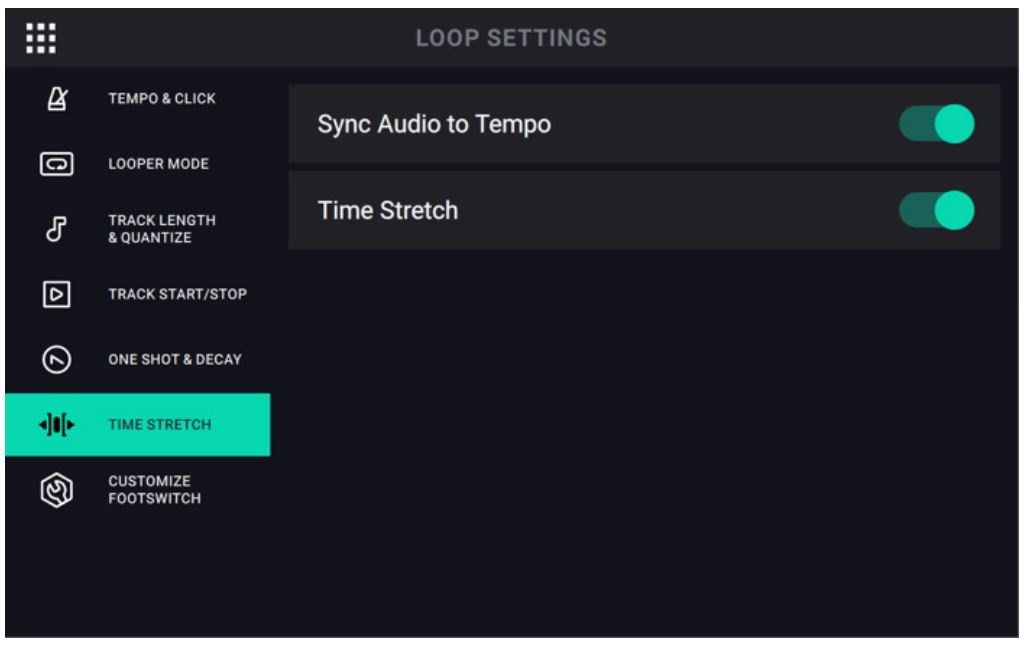
Time-Stretch Tab:
Sync Audio to Tempo: This setting determines whether changes in tempo affect your loop’s audio. Set to On to enable changes to your loop’s audio according to changes in tempo. Set to Off to leave your loop’s audio unaffected by changes to the tempo.
Time Stretch: This setting determines whether changes in tempo affect your loop’s audio and pitch. You can stretch your recorded audio to be anywhere from half the speed of the original recording, all the way to up to twice as fast as the original recording. For example, if you recorded your loop at 120 BPM, you could stretch it to be as slow as 60 BPM or as fast as 240 BPM while still retaining the pitch of the original recording without any unwanted artifacts. Set to On to enable or Off to disable.

Customize Footswitch Tab:
Tap the arrow next to Customize Footswitches to customize the •Stop/-Undo footswitches for each for the four looper tracks to perform other looper functions, thus reducing the amount of footswitch presses needed to access your favorite HeadRush Looperboard functions.
You can customize each track •Stop/-Undo footswitch to perform the function for one looper track or multiple looper tracks. Similarly, if you are using the FX ON/OFF function, you can set the footswitch to enable/bypass one FX rack, or multiple FX racks.
Once you have entered the customization page:
- You can select the footswitch’s function by tapping the downward arrow.
- Then, you can select which tracks the footswitch should affect by tapping the four boxes labeled TRACK or RACK 1-4
After you’re done customizing the footswitch, the current function of the switch will show up in the track information boxes that are shown on the Timeline and Mixer pages.

Some additional important notes:
When this feature is enabled, the •Rec/Play/Dub footswitch for each track functions as normal, but you can also perform start/stop functions:
- When the track already contains audio, you will now be able to start the looper track by pressing the •Rec/Play/Dub footswitch when the track is stopped.
- If the track does not contain audio, then the track will start to Record once you press the •Rec/Play/Dub footswitch.
- You will be able to stop the looper track by double tapping the •Rec/Play/Dub footswitch when the looper track is playing.
- If you want the function of each track’s start/stop footswitch to return to their original functionality when you create a new loop, make sure to change the RESET ON NEW LOOP setting to ON.
- If you want your customized footswitches from your current loop to carry over when you create a new loop, make sure to change the RESET ON NEW LOOP setting to OFF.
Storage
As you create and save loops, your HeadRush Looperboard’s internal storage may become full. To prevent this, you can connect external USB or SD storage as needed. This gives you virtually unlimited storage of loops!
To enter the Storage page, tap the Navigation Menu icon in the top-left corner, and then tap the Storage icon.

On the storage page, you will see meters that show the available storage space as well as the remaining available looping time for HeadRush Looperboard’s internal storage, as well as any connected USB/SD external storage devices.
To select a new storage device to use for looping, tap the name of the device. Once the device has been selected, all new loops created will be stored using this device.
After making your selection, you can exit the Storage page by tapping the Navigation Menu icon in the top-left corner of the touchscreen.
Tip: If you save a loop to an external storage device before changing to the external storage device on the storage page, you will still be working with the loop in its initial location. If you want to continue to work on the external storage device, you will need to load the loop from its new storage device.
Important: To avoid file loss or damage to your media, only disconnect external USB and SD storage devices from HeadRush Looperboard while it is powered off. Alternatively, tap the device’s eject icon on the storage page.
Audio Routing
You can use the Audio Routing page to control where your input, looper track and output audio signals are sent. These settings are global settings (not per loop) so that you can quickly configure HeadRush Looperboard to work best for your gear and performance settings.
To show the Audio Routing page, tap the Audio Routing icon on the Navigation Menu page.
To show the page for the inputs, tracks, or outputs, tap Input Setup, Track Setup or Output Setup, respectively.
Input Setup
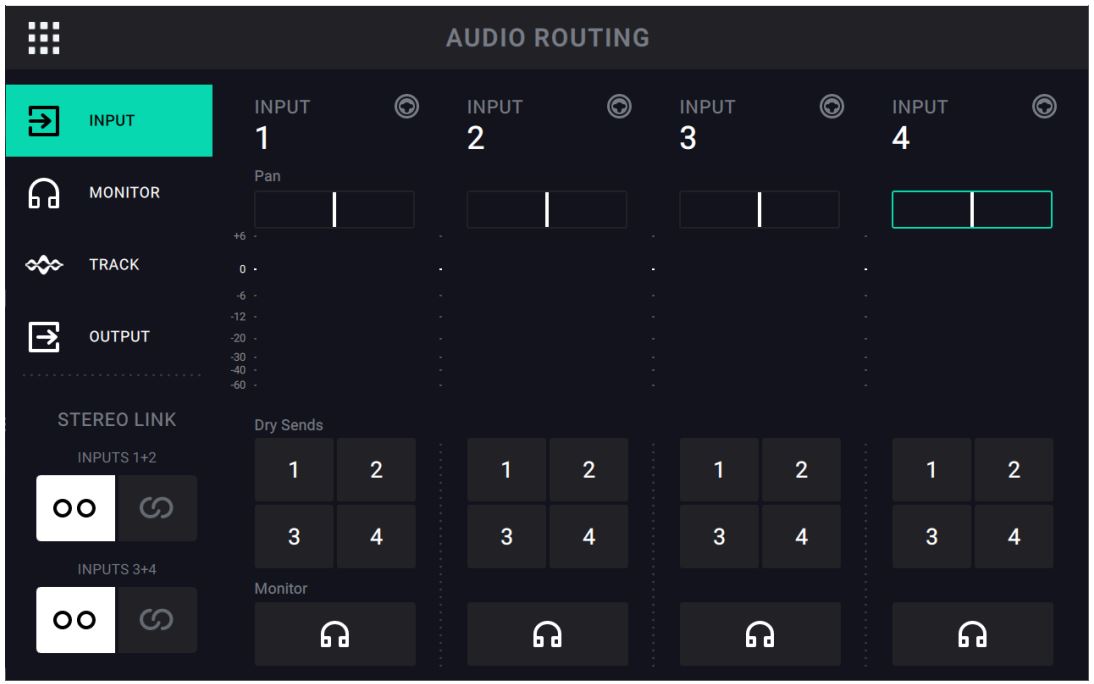
To adjust the level of an input signal, turn its Input Gain knob (1–4) on the top panel.
To adjust the panning of an input signal, tap its Pan slider and drag left or right. You can enlarge this slider to make more detailed adjustments by double-tapping.
To select an output to directly monitor the input signal, tap the desired Output 1–4 button under Dry Sends, or the Headphones Icon button under Monitor. Audio signal from the input will be sent directly to the selected output(s). Use the Main and Phones knobs to adjust the output volume level of the outputs and phones, respectively.
To stereo link your inputs if you are using a stereo audio source (e.g., drum machine, keyboard, etc.), tap the On button for Inputs 1+2 and/or Inputs 3+4 under Stereo Link on the right side of the touchscreen. Tap the Off button to disable stereo link.
Monitor Setup
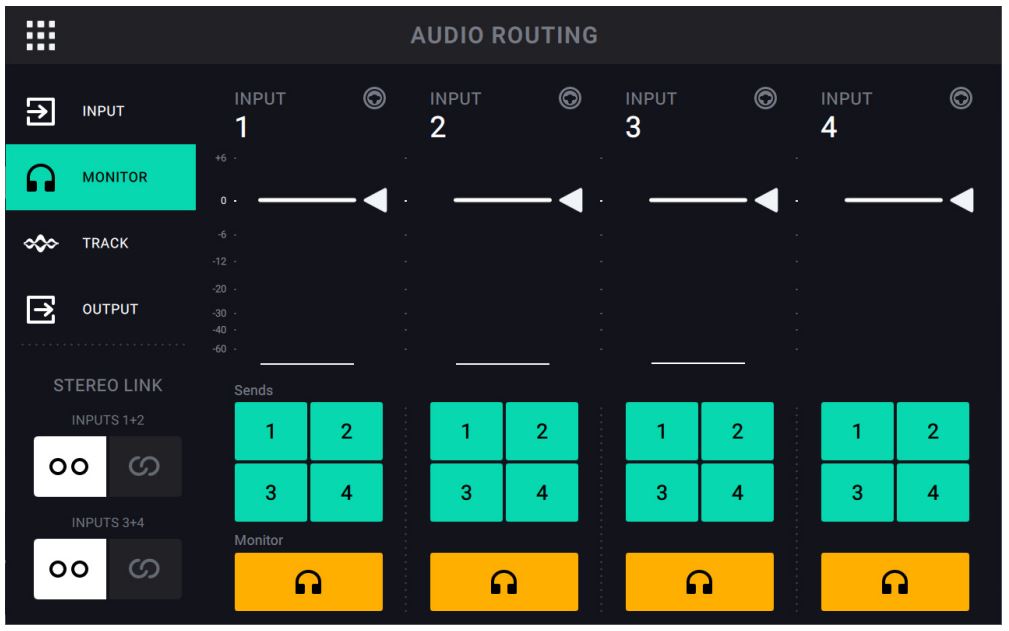
You can use the Monitor Setup page for listening to your inputs while recording, overdubbing, and playing back loops. You can control the level of each input, as well as which output that you would like to monitor to them on.
To adjust the monitor level of an input, tap and drag the white line at the top of its meter.
To select an output for monitoring, tap the desired Output 1–4 buttons under Sends, or the Headphone Icon monitor button.
Track Setup
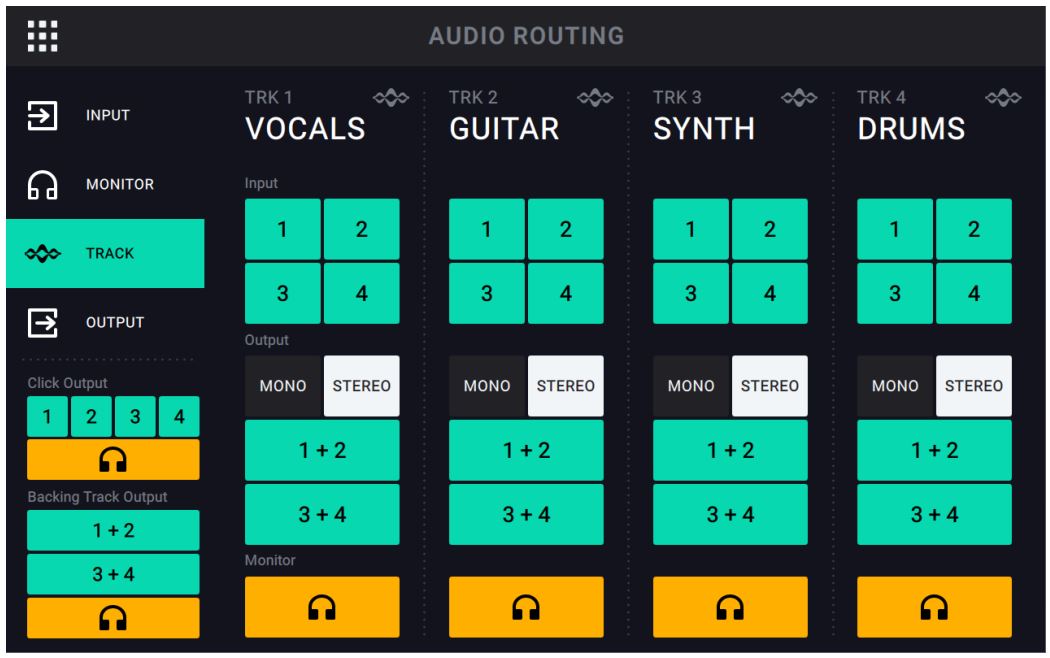
To route an input to a looper track, tap the desired Input 1–4 button. When Stereo Link is enabled, Inputs 1+2 and/or Inputs 3+4 will be selected together.
To select a track output mode, tap the Mono (monoaural) or Stereo (binaural) buttons.
To route a track to an output, tap the desired Output 1–4 button. If the output mode is Stereo, Outputs 1+2 and/or Outputs 3+4 will be selected together.
To route a track to the phones output, tap the headphone icon at the bottom of each track. Use the Phones knob to adjust the output volume level.
To route the click to an output, tap an Output 1–4 button under Click Output on the left side of the touchscreen. Tap the headphone icon to route the click to the phones output. Use the Main and Phones knobs to adjust the output volume level of the outputs and phones, respectively.
To select routing for the stereo backing track, tap the 1+2 or 3+4 buttons under Backing Track Output on the left side of the touchscreen. Tap the headphone icon to route the backing track to the phones output. Use the Main and Phones knobs to adjust the output volume level of the outputs and phones, respectively.
Output Setup
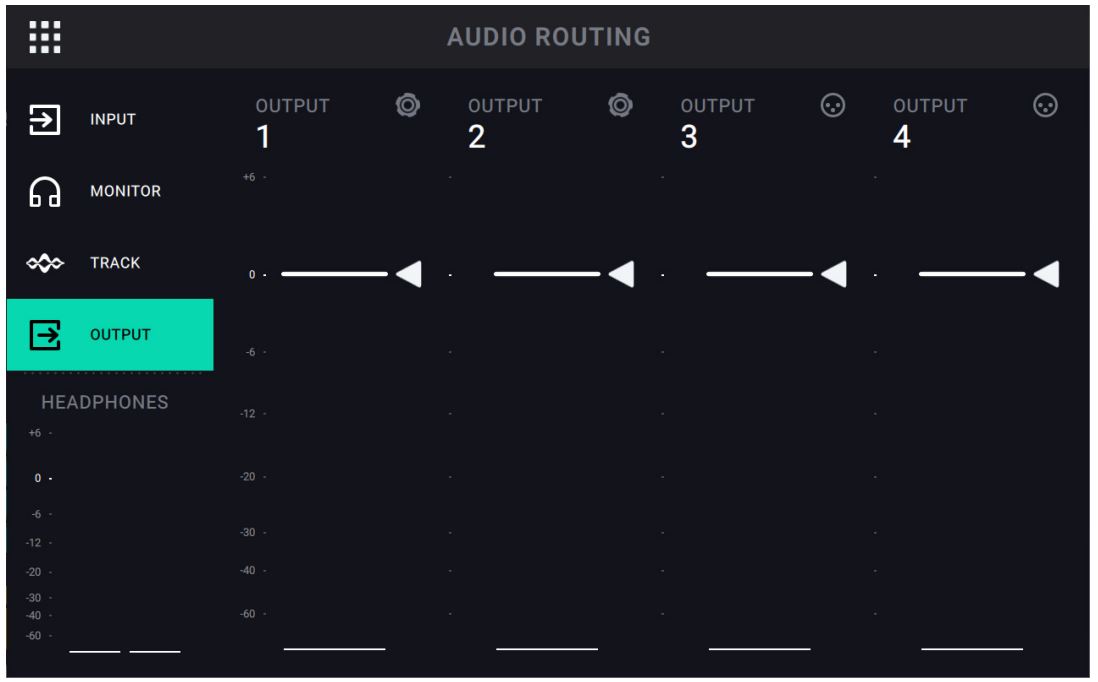
To adjust the output level of an individual output, tap and drag the white line at the top of its meter.
Functions
Press the Function footswitch to show the Functions page in the touchscreen. The footswitch indicator will be lit orange.
To select a function, press the corresponding footswitch (labeled on the top panel in orange) or tap it on the touchscreen.
To exit the Functions page, press the Function/Exit footswitch.

You can access these functions by using their corresponding footswitches 3–6 or 9–12 or tapping the respective icon on the touchscreen:
Length:
Use footswitches 3–6 to adjust the length of the full loop by 1/2, 2X, 4 or 8X. If the minimum or maximum length limits have been reached, unavailable options will be grayed out.
The total loop length will be shown in the box below.
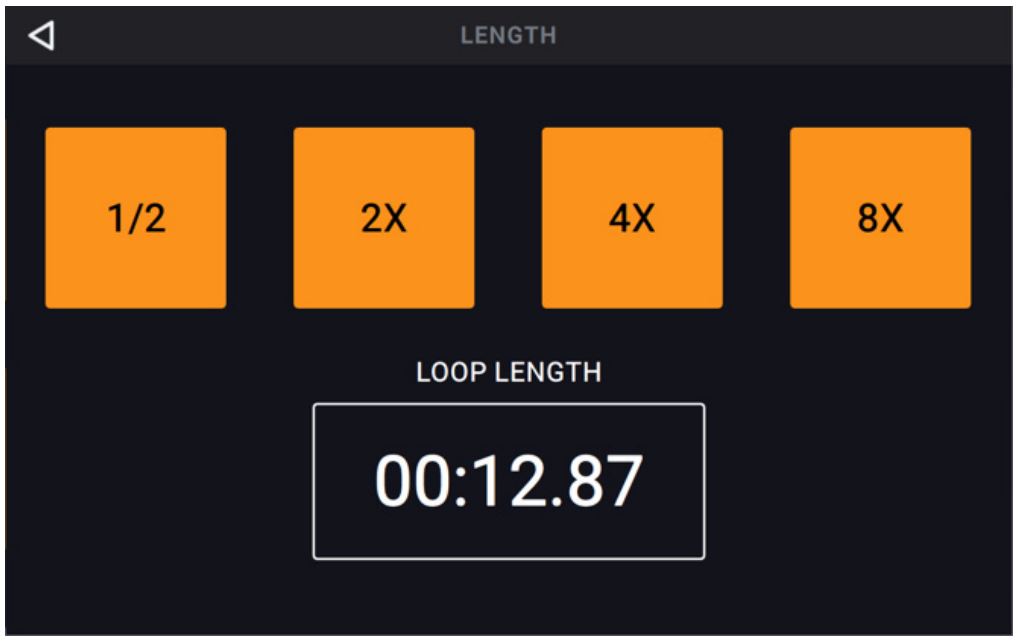
Speed:
Use footswitches 3–6 to adjust the speed (and pitch) of the full loop by 1/2, 2X, 4 or 8X. If the speed limits for the loop have been reached, unavailable options will be grayed out.
The current speed setting will be shown in the box below.
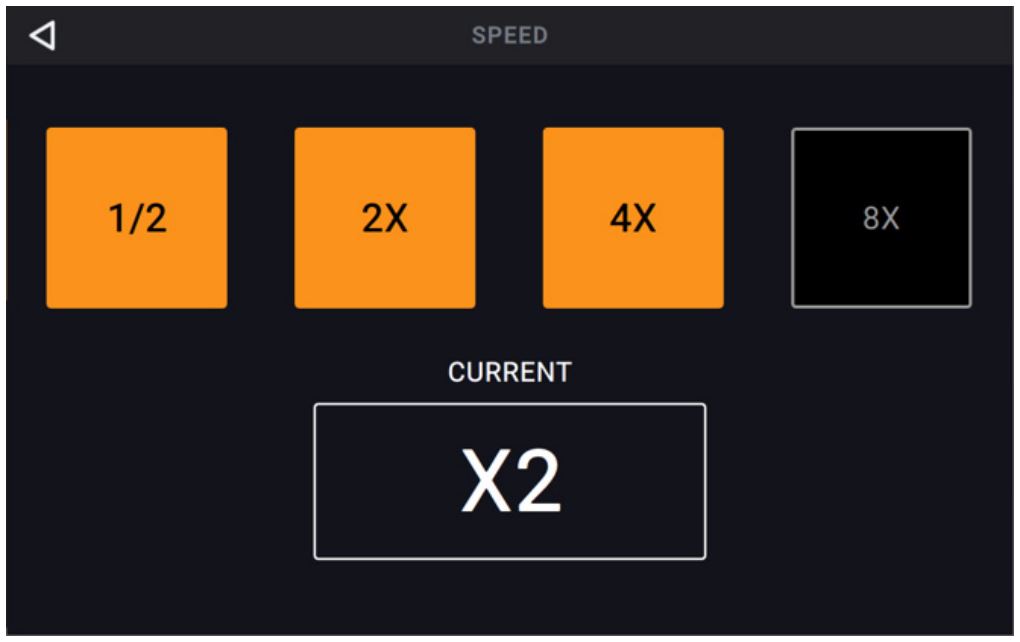
Reverse:
Use footswitches 3–6 to adjust the playback direction of each looper track. If no looper track is recorded, the track option will be grayed out.
You can also use footswitch 9 to adjust the playback direction of all looper tracks at the same time.

Fade:
Use footswitches 3–6 to apply a fade out or fade in to each looper track. If the track is playing and available to fade out, the track option will be orange. If the track is stopped and available to fade in, the track option will be white.
Use footswitches 10–11 to adjust the rate of the fade, or tap the corresponding buttons on the touchscreen.
You can also use footswitch 9 to apply the fade function to all tracks at the same time. If some tracks are playing and some tracks are stopped, this function will cross-fade the tracks.
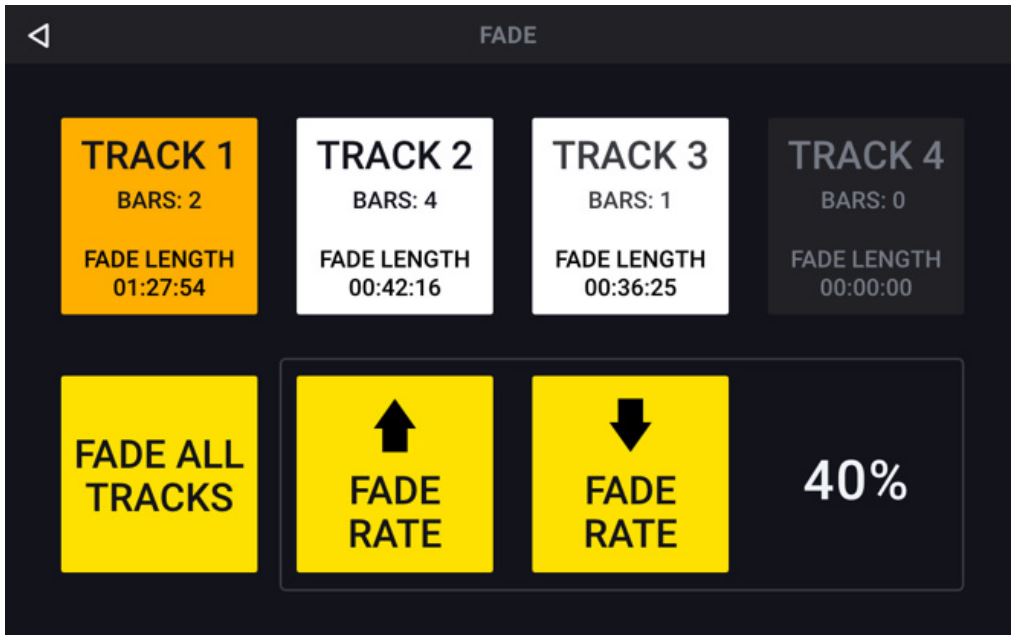
Transpose:
Use footswitches 3–6 to select a looper track to adjust the transposition.
Use footswitch 9 to select all looper tracks at the same time.
Use footswitches 10–11 to adjust the amount of transposition (in semitones) for the selected track.
Use footswitch 12 to enable or disable transposition for all tracks, whether they are currently selected or not. If the transposition for a track is set to 0, no change is made.

Peel:
Use footswitches 3–6 to permanently “peel off” the last recorded layer of a looper track.
If no layers are available to be peeled, the looper track will be grayed out.

Bounce:
On the first Bounce page, use footswitches 3–6 to select which tracks you would like to bounce. Then, press footswitch 9 to navigate to the next page.
If the looper track is empty, the option will be grayed out.
On the next Bounce page, use footswitches 3–6 to select the destination looper track for the bounce.
When As Loop is enabled, reverb and delay FX on each bounced track will not be cut off at the loop point. When As Loop is disabled, reverb and delay FX on each bounced track will be cut off at the loop point.
Use footswitch 9 to perform the bounce, or press footswitch 10 to cancel and return to the previous page.


Clear:
Use footswitches 3–6 to permanently clear all audio from a looper track. If there is no audio on a looper track, the option will be grayed out.
Use footswitch 9 to clear all audio from all tracks at once. If there is no audio on all looper tracks, the option will be grayed out.
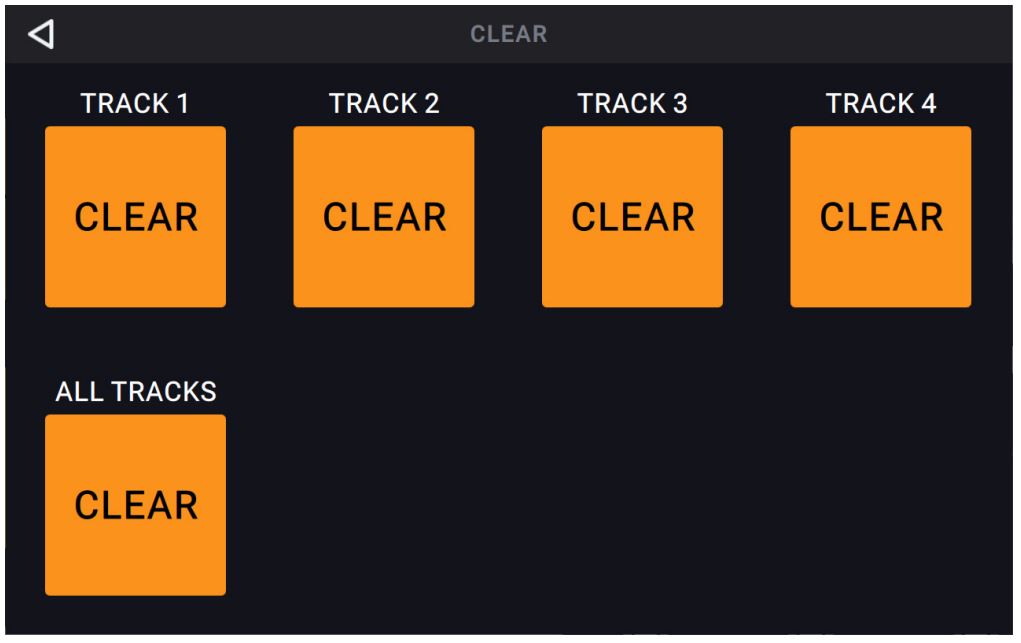
You can access these functions by using the corresponding footswitches 1–2 and 7–8 only:
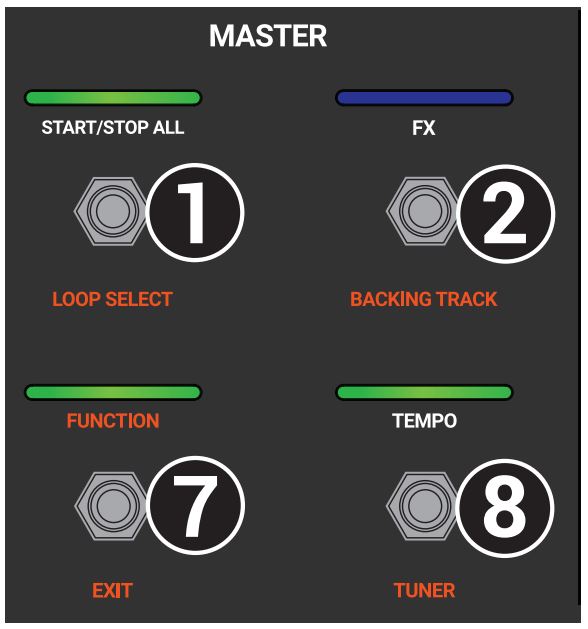
Loop Select:
Select this option to load a loop using the footswitches. You are only able to select loops that are on the same storage device and in the same folder as the currently loaded loop.
Use footswitches 3–5 and 9–11 to load a different loop.
Use footswitches 6 and 12 to move up or down in your banks of loops.

Backing Track:
Select this option to control the Backing Track feature.
Exit:
Use footswitch 7 to return to the previous page from the Functions page.
Tuner:
When using the built-in tuner, all input signal will be muted from the outputs. Loop playback will continue to play back to the outputs.
If you would like to leave an input active, tap the Mute Inputs 1-4 buttons in the lower right corner to unmute the input. This is useful in performance situations where you would still like the ability to talk to your crowd while tuning your muted guitar.
Tap the Pitch Reference and use the encoder to adjust the tuning reference frequency. The default is 440 Hz.

Backing Track Player
The Backing Track feature enables you to play audio files (.WAV or .MP3) when you are not looping. This feature operates completely independently from the four looper tracks, and can be especially useful for performance situations when you need a simple backing track accompaniment.
Backing Tracks can be played directly from internal storage, or from external USB/SD storage devices. Backing tracks can be loaded to the HeadRush Looperboard’s internal storage by using the USB Connection. See the following chapter to learn more.

To select a backing track, tap the drop-down menu below File.
To adjust the Track Level, tap the current Track Level dB setting and then turn the encoder to change the value. You can also adjust this on the Mixer page.
To rewind the currently selected backing track, press footswitch 3.
To stop the currently playing backing track, press footswitch 4.
To play the currently selected backing track, press footswitch 5.
To fast forward the currently selected backing track, press footswitch 6.
To load the previous backing track, press footswitch 9.
To load the next backing track, press footswitch 12.
USB Connection
You can use the HeadRush Looperboard’s USB Type-B Port to connect to a computer for Transferring Files and Settings (such as loops, backing tracks, etc.), or for Recording (to a digital audio workstation [DAW]).
Transferring Files and Settings
You can transfer loops, backing tracks, audio for importing and FX Rack preset files over a USB connection between your computer and HeadRush Looperboard.
To transfer files between HeadRush Looperboard and your computer:
- Use a standard USB cable to connect HeadRush Looperboard’s USB Type-B Port to an available USB port (type-A) on your computer.
- With your computer already powered on, power on HeadRush Looperboard using the power switch.
- Tap the Navigation Menu icon in the top-left corner of the touchscreen, and then tap USB Transfer.
- On your computer, HeadRush Looperboard will appear as a mass-storage device called HeadRush.Windows users: If this is the first time you have connected HeadRush Looperboard to your computer, you may need to wait a minute while the class-compliant drivers are installed.
- Open the HeadRush drive. You can now freely click and drag contents between HeadRush and your computer. Note that any changes you make to the contents of your HeadRush are immediate and cannot be cancelled.Important: When you are finished transferring contents, you must unmount/eject the HeadRush drive from your computer.
- After the drive has been ejected, tap Sync on your HeadRush Looperboard to “commit” any changes you made to the contents of the HeadRush drive. An additional prompt will appear to confirm you have ejected the drive. Tap Proceed to continue or Cancel to continue accessing files on your computer.
Important:
Do not disconnect or power off HeadRush Looperboard or your computer during the process. Doing so may result in damage.
Any files unsupported by HeadRush Looperboard will be ignored.
You cannot transfer an archived folder (such as a .zip) to and from HeadRush Looperboard. Instead, transfer supported files directly.
Recording
When connected to your computer using the USB Type-B Port, you can select and use the HeadRush Looperboard as a 24-bit audio interface, enabling you to play audio through it or send its audio signal to your computer. The HeadRush Looperboard can operate at sample rates of 44.1, 48, 88.2 or 96 kHz.
Important Note for Windows Users: Before connecting HeadRush Looperboard to your computer, download and install the necessary drivers from headrushfx.com/support.
To use HeadRush Looperboard as an audio interface:
- Use a standard USB cable to connect HeadRush Looperboard’s USB Type-B Port to an available USB port (type-A) on your computer.
- With your computer already powered on, power on HeadRush Looperboard using the power switch.
- Tap the Navigation Menu icon in the top-left corner of the touchscreen, and then tap the Global Settings icon.
- Under the USB Audio tab, set Enable to On.
- On your computer, open the Control Panel (Windows®) or System Preferences (macOS®) menu.
- Open the sound or audio settings, and then select HeadRush Looperboard as the device for recording/input and/or for playback/output.The HeadRush Looperboard will send a stereo audio signal to your computer. This stereo audio signal mirrors your analog main outputs 1 and 2, and can be selected as an input in your digital audio workstation (DAW).The HeadRush Looperboard will also receive a stereo audio signal from your computer. The channels are named and routed directly out of the HeadRush Looperboard’s main outputs and phones output. You can adjust the level of the incoming audio signal in the Global Settings.
External MIDI Control
The HeadRush Looperboard can be controlled by incoming MIDI CC (control change) messages or MIDI Note messages from external MIDI gear. These MIDI messages can be received from hardware connected to the USB Type-A Ports or the 5-pin MIDI Input.
Tip: You can enable or disable this feature and change the MIDI Channel used for HeadRush Looperboard to receive messages in the Global Settings menu.
The chart below lists the available parameters that can be controlled by external MIDI hardware:
MIDI Control: Variable Parameters
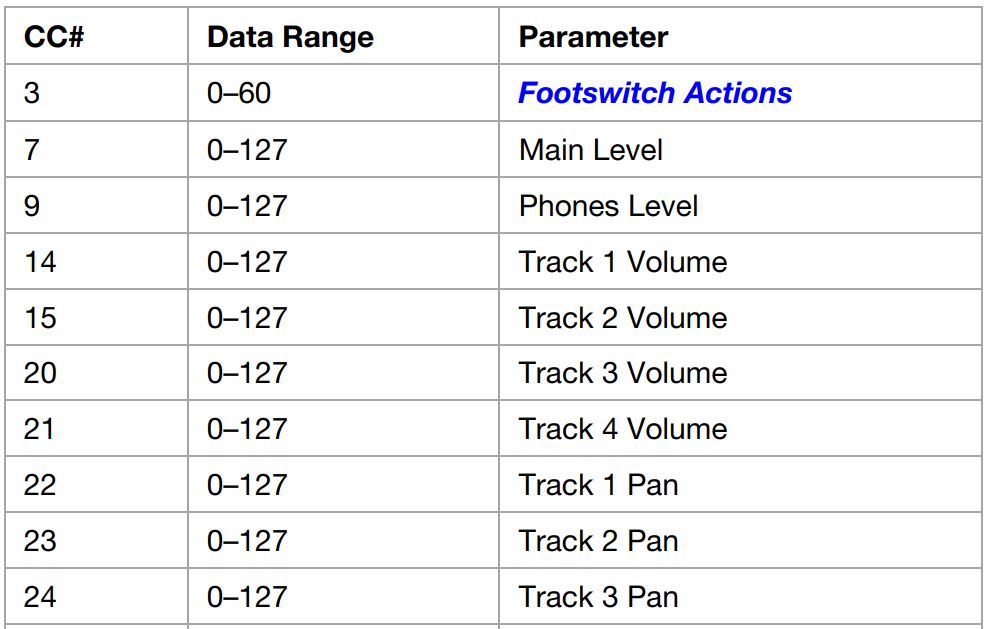

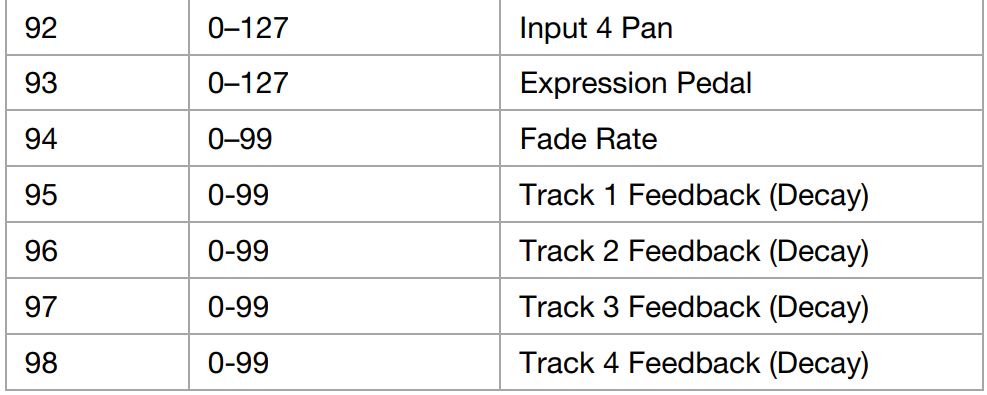
MIDI Control: Footswitch Actions (CC#3 or MIDI Note)
All actions on this page are triggered by sending the listed Data Messages using MIDI CC#3 messages, or by sending MIDI note messages.



MIDI Clock Receive
The HeadRush Looperboard can be synced to the tempo of an external MIDI device (e.g., a drum machine) while recording and playing your loops in Fixed, Sync and Serial-Sync modes.
The HeadRush Looperboard can receive MIDI clock from a device connected to the traditional 5-pin MIDI Input, or from a class compliant device connected to the USB Type-A Ports on the rear panel. You can enable or disable the MIDI Clock Sync feature, as well as set the MIDI Clock Source, in the Global Settings menu.
Tips:
- Tempo cannot be changed during recording, so make sure the HeadRush Looperboard is accurately receiving the MIDI clock before beginning.
- Receiving MIDI Clock Sync works best when using properly cut loops. Loops that are miscut or have odd or uncommon bar lengths may not work properly or cause unexpected results.
When MIDI Clock Receive is enabled:
- Looper tracks can be armed for recording or overdubbing by pressing their respective
•Rec/Play/Dub footswitches. The LEDs for these footswitches will flash when the track has been armed and is ready for recording or overdubbing.
o If the external MIDI device’s clock is not running yet, and the looper track mode is set to Fixed, tracks will begin recording or overdubbing when a MIDI Start command is received.
o If the external MIDI device’s clock is already running, and the looper track mode is set to Fixed, tracks will wait to begin recording or overdubbing until the next downbeat.
o If the external MIDI device’s clock is already running, and the looper track mode is set to Sync or Serial-Sync, tracks will wait for the master track to return to the beginning to begin recording or overdubbing. - HeadRush Looperboard will stop recording or overdubbing once a MIDI Stop command is received from the external MIDI device.
- If the external MIDI device’s clock is running, looper track playback can be started and stopped using the •Stop/–Undo footswitch.
o In Fixed mode, tracks will stop immediately after pressing the •Stop/ Undo footswitch.
o In Sync or Serial-Sync mode, tracks will stop when the end of the master track is reached. - If the external MIDI device’s clock is not running, looper track playback cannot be started and stopped using the •Stop/–Undo footswitch.
- The loop’s tempo cannot be manually changed.
- The Sync Audio to Tempo feature in Global Settings cannot be disabled.
- The Start/Stop All and After Record features in Global Settings will not be applied.
MIDI Clock Send
HeadRush Looperboard can send MIDI clock and MIDI start/stop messages to an external MIDI device (e.g., a drum machine) while recording, overdubbing, and playing your loops in Fixed, Sync and Serial-Sync modes.
HeadRush Looperboard can also send MIDI clock from a device connected to the traditional 5-pin MIDI Output, or from a class compliant device connected to the USB Type-A Ports on the rear panel.
You can enable or disable the MIDI Clock Sync feature, as well as set the MIDI Clock Destination, in the Global Settings menu.
Tip: Sending MIDI Clock works best when using properly cut loops. Loops that are miscue or have odd or uncommon bar lengths may not work properly or cause unexpected results.
Global Settings
Use the Global Settings page to configure HeadRush Looperboard’s overall settings, including settings that affect all loops.
To show the Global Settings, tap the Navigation Menu icon in the top-left corner of the touchscreen, and then tap the Global Settings icon.
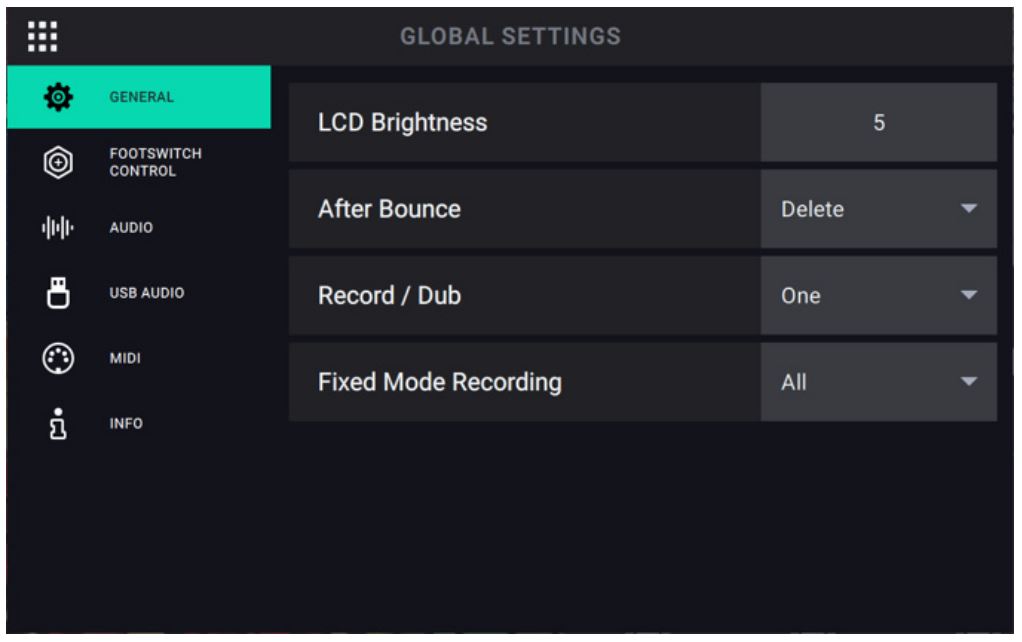
General Tab:
LCD Brightness: This setting determines the brightness of HeadRush Looperboard’s touchscreen. Tap the field and turn the encoder clockwise to increase the brightness. Turn the encoder counter-clockwise to decrease the brightness.
After Bounce: This setting determines what happens to the source tracks after a bounce has been performed. Set this to Delete to remove the source tracks after a bounce. Set this to Keep to retain the source tracks after a bounce.
Record/Dub: This setting determines how many tracks that HeadRush Looperboard can record or overdub at a time. Set this to One if you would like to reduce the amount of footswitch presses when building a loop. Set this to Multi if you would like to be able to record or overdub more than one track at once.
Fixed Mode Recording: This setting determines how looper track playback is triggered after all tracks have been stopped in Fixed mode. When set to All, pressing a •Rec/Play/Dub footswitch for one track will cause that track to begin recording or overdubbing and all other looper tracks to play back. When set to Solo, pressing a •Rec/Play/Dub footswitch for a track will cause only that track to begin recording or overdubbing.

Footswitch Control Tab:
Rec/Play/Dub After Record: This setting determines what HeadRush Looperboard will do after an initial layer is recorded on a looper track. When set to Play, the looper track will begin playback after the initial layer is recorded. When set to Overdub, the looper track will immediately start overdubbing after the initial layer is recorded.
Rec/Play/Dub After Stop: This setting determines what HeadRush Looperboard will do when a track’s Rec/Play/Dub footswitch is pressed for a stopped track. When set to Play, the looper track will begin playback of the track. When set to Overdub, the looper track will begin overdubbing to the track.
Rec/Play/Dub Hold Function: This setting determines what HeadRush Looperboard will do when a track’s Rec/Play/Dub footswitch is held for more than 1.5 seconds. This hold function can be assigned to Peel or Clear the track.
Stop/Undo Hold Function: This setting determines what HeadRush Looperboard will do when a track’s •Stop/-Undo footswitch is held for more than 1.5 seconds. This hold function can be assigned to Undo/Redo or Clear the track.
Important: If a track only has 1 layer, performing the undo function will clear the track, and the layer cannot be restored.
Stop/-Undo Function: This setting determines whether the individual •Stop/-Undo footswitch functions will perform its action when the footswitch is initially pressed (On Press), or when it is released (On Release).
Start/Stop All After Stop: This setting determines what happens after you use the Start/Stop All footswitch to stop all of your tracks and then press it again. When set to Return, all tracks will start at the beginning of the loop. When set to Pause, all tracks will restart from where you initially hit the Start/Stop All footswitch to stop all tracks.
Note: This parameter only applies when using Fixed, Serial or Free Looper Modes.
Start/Stop All Function: This setting determines what HeadRush Looperboard whether the Start/Stop All footswitch function will perform its action when the footswitch is initially pressed (On Press), or when it is released (On Release).
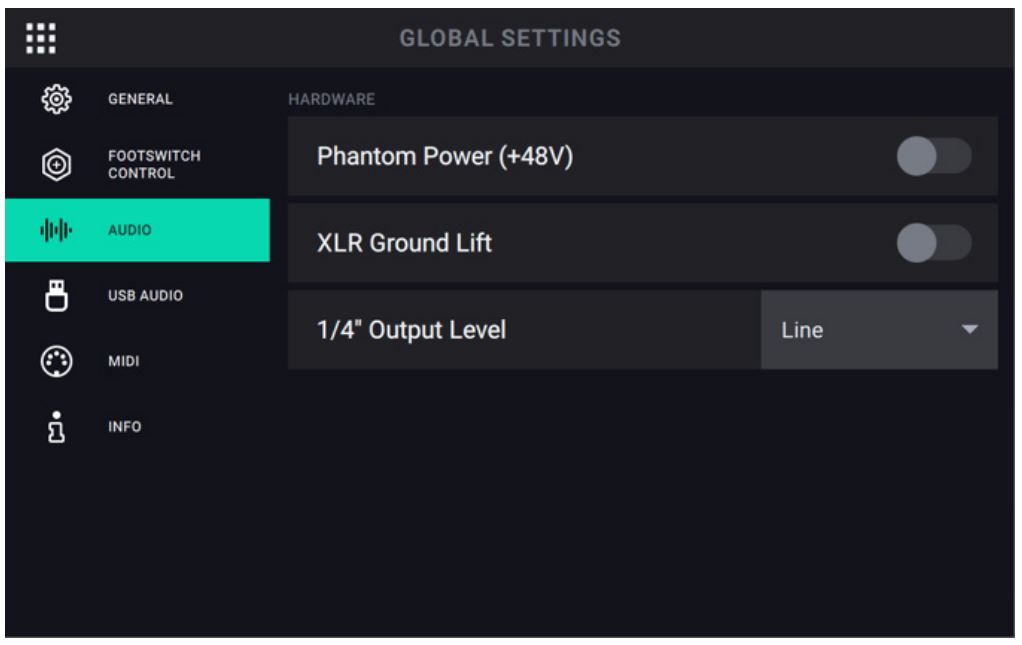
Audio Tab:
Phantom Power (+48V): This setting determines whether phantom power (+48V) is enabled (On) or disabled (Off) for all four Inputs.
Important: Only enable phantom power if your microphone requires it. Most dynamic microphones and ribbon microphones do not require phantom power, while most condenser microphones do. Consult your microphone’s documentation to find out whether it needs phantom power.
XLR Ground Lift: This setting determines whether the XLR ground lift feature is enabled (On) or disabled (Off). Use this feature to reduce hum or noise in the signal from the XLR Outputs.
1/4 Output Level: This setting determines the output level of the 1/4″ Outputs. When set to Line, the output level will be +18 dBu. Use this setting if you are connecting HeadRush Looperboard to a full-range, flat-response amplifier, PA speaker, mixer or audio interface. When set to Amp, the output level will be +6 dBu. Use this setting if you are connecting the HeadRush Looperboard to a traditional guitar amplifier.
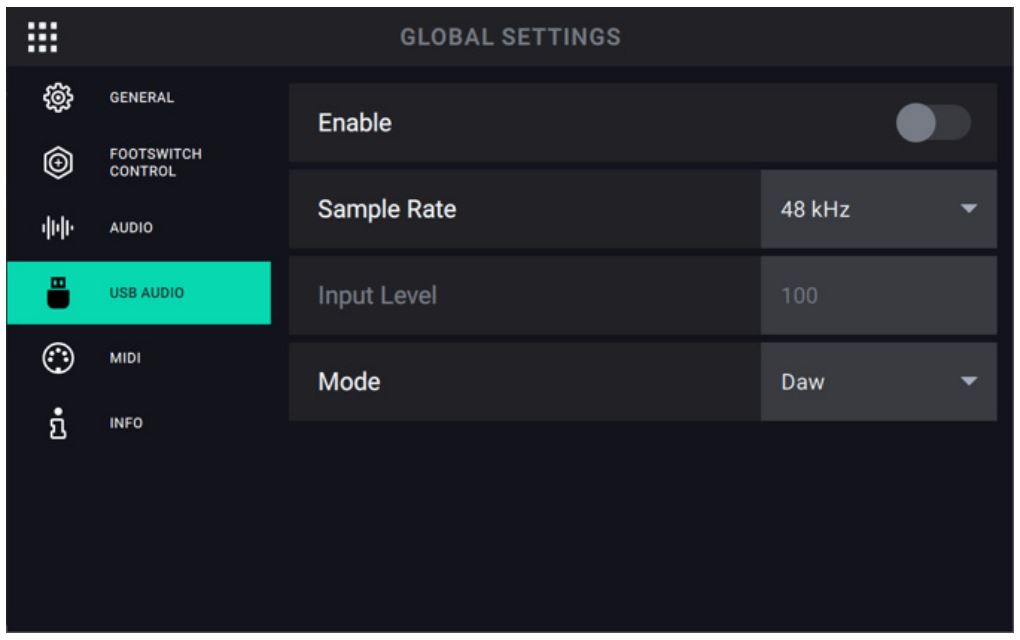
USB Audio Tab:
Enable: This setting determines whether or not HeadRush Looperboard is sending a USB audio signal over a USB connection. Set to On to enable sending of the USB audio signal with the selected Sample Rate. Set to Off to disable the USB audio signal. (To change the Sample Rate, set USB Audio to Off first, select the correct sample rate, set USB Audio to On again, and restart your DAW.)
Sample Rate: This setting determines the sample rate of the USB audio signal: 44.1 kHz, 48.0 kHz, 88.2 kHz or 96.0 kHz. Remember to select the same sample rate as the one in your DAW. Also, set it before opening your DAW.
Input Level: This setting determines the incoming level of the USB audio signal coming from your computer.
Mode: This setting determines what audio signal how the HeadRush Looperboard sends its audio signal over the USB connection and how its outputs function while doing so:
- Live: The audio signal will be sent to your computer as well as to the HeadRush Looperboard’s outputs.
- DAW: The audio signal will be sent to your computer only. The HeadRush Looperboard’s outputs will be disabled to prevent any latency while monitoring.

MIDI Settings Tab:
MIDI Clock Receive: This setting determines whether HeadRush Looperboard will sync to an external MIDI clock source. Set to On to sync tempo to an external source, or set Off to disable.
MIDI Clock Source: This setting determines how HeadRush Looperboard will receive MIDI clock messages. Tap the field and then use the encoder to select the desired source. Select Looperboard to receive MIDI clock messages from the 5-pin MIDI Input on the rear panel. If you have a class-compliant MIDI device connected to the USB Type-A Ports, select the device’s name to set it as the MIDI clock source.
MIDI Clock Send: This setting determines whether HeadRush Looperboard will send MIDI clock to an external MIDI clock destination. Set to On to send MIDI clock to an external device, or set to Off to disable.
MIDI Clock Offset: This setting determines can be used to set an offset (-10ms to 10ms) for sent MIDI clock to an external destination. This is sometimes needed to compensate for delays that are introduced by some MIDI hardware. Tap this field and turn the encoder to choose a setting.
MIDI Clock Destination: This setting determines how HeadRush Looperboard will send MIDI clock messages. Tap the field and then use the encoder to select the desired destination. Select Looperboard to send MIDI clock messages from the 5-pin MIDI Output on the rear panel. If you have a class-compliant MIDI device connected to the USB Type-A Ports, select the device’s name to set it as the MIDI clock destination.
MIDI Thru: This setting determines the function of the MIDI Output. When set to On, MIDI sent to the HeadRush Looperboard MIDI Input will be sent directly to the MIDI Output. When set to Off, HeadRush Looperboard will only send its own MIDI information out of the MIDI output.
External MIDI Control: This setting determines whether HeadRush Looperboard will respond to incoming MIDI CC and MIDI Note messages. When set to On, HeadRush Looperboard will receive MIDI CC and MIDI Note messages from an external device on the selected channel.
When set to Off, HeadRush Looperboard ignore incoming MIDI CC and MIDI Note messages.
External MIDI Channel: This setting determines which channel that HeadRush Looperboard will listen to when set to respond to incoming MIDI CC and MIDI Note messages. To change the MIDI Channel, tap the field and then turn the encoder to select the channel, 1–16 or Omni (all channels).

Info Tab:
On this tab, you can view the currently installed firmware version. You can also access HeadRush Looperboard’s EULA by tapping the License field.
Appendix
Technical Specifications
All specifications are measured at 20 kHz bandwidth. Specifications are subject to change without notice.

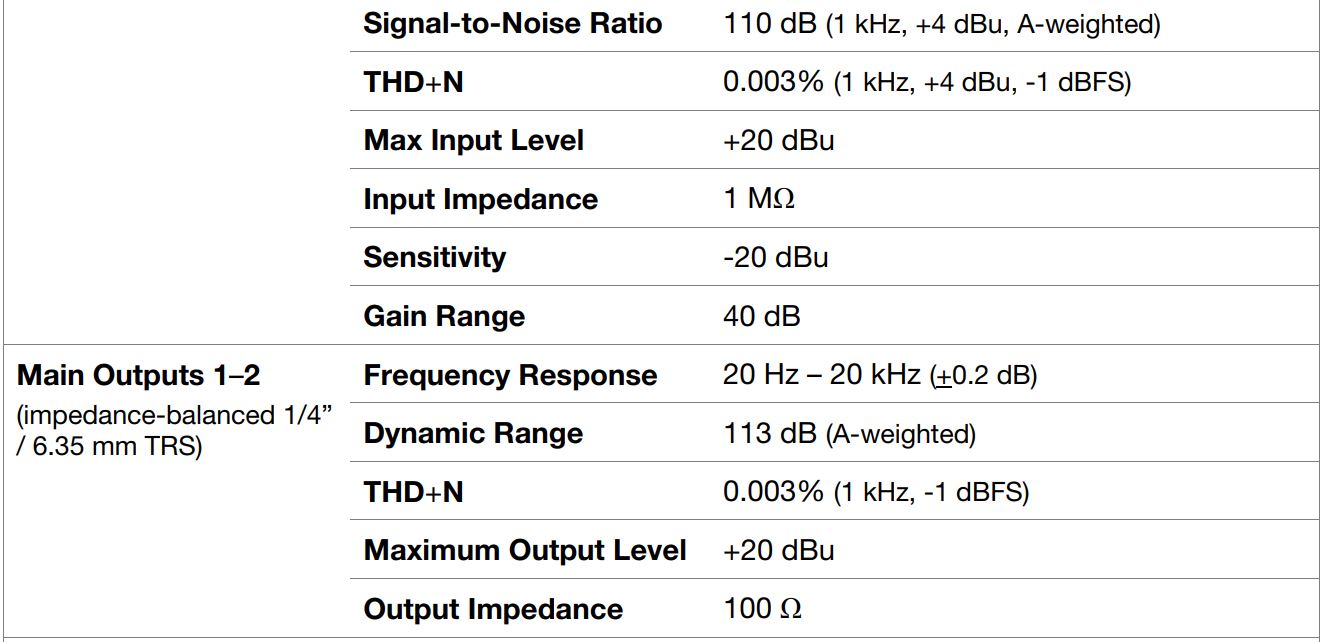






Trademarks & Licenses
HeadRush is a trademark of inMusic Brands, Inc., registered in the U.S. and other countries.
SD is a registered trademark of SD-3C, LLC.
macOS is a trademark of Apple Inc., registered in the U.S. and other countries.
Windows is a registered trademark of Microsoft Corporation in the United States and other countries.
All other product names, company names, trademarks, or trade names are those of their respective owners.
